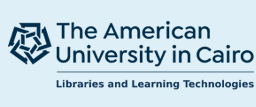-

Energy harvesting of gas pipeline vibration
M. Arafa, W. Akl, M. Majeed, K. Al-Hussain, and A. Baz
[abstract not available]
-

Damage identification through spectral element model updating
Mustafa H. Arafa and Ashraf O. Nassef
[abstract not available]
-

A Modified Continuous Reactive Tabu Search for damage detection in beams
Mustafa Arafa, Ayman Youssef, and Ashraf Nassef
[abstract not available]
-

A simulation-based planning system for wind turbine construction
Dina Atef, Hesham Osman, Moheeb Ibrahim, and Khaled Nassar
[abstract not available]
-

An innovative approach for the wormhole attack detection and prevention in wireless ad hoc networks
Marianne A. Azer, Sherif M. El-Kassas, and Magdy S. El-Soudani
[abstract not available]
-

AgriMine: A tool for mining agricultural problems and their solutions
Samhaa R. El-Beltagy, Ahmed Rafea, Said Mabrouk, and Mahmoud Rafea
[abstract not available]
-

Traffic control using WiMAX with Dual Trigger Handover
M. A. El-Dakroury, Abdel Halim Zekry, H. H. Amer, and R. M. Daoud
[abstract not available]
-

Community based learning in ENGR 101 term project: Toy design for school children in disadvantaged Old Cairo community
Lamyaa El-Gabry
Introduction to Engineering (ENGR 101) is the first engineering course students take upon admission to the engineering program. It is required of students in all disciplines of engineering. It is a one credit hour course that meets once a week and covers topics including History of Engineering, Engineering fields of specializations, the engineering profession, engineering communications, engineering ethics and societal obligations. It also focuses on teaching students the engineering approach to problem solving and includes a course project. Community Based Learning was introduced into the ENGR 101 course via the term project which is a required component of the course. The project was to design toys for children ages 7 to 14 years at a school in a disadvantaged squatter community in Old Cairo, Egypt, where infrastructure is poor and education and social mobility can be very limited. The project was carried out in partnership with a non-government organization (NGO) named "Sohbit Khayr" based in the Stable Antar neighborhood in Old Cairo. This paper shows how the introductory engineering course was redesigned to integrate community based learning while meeting the stated ABET course outcomes. Included are detailed step-by-step instructions on the tools and structure of the project so that it may serve as an example for others wishing to adapt some of these tools to other courses. The paper will present the outcome assessments and survey results to evaluate the project's success in meeting the stated outcomes and includes a discussion on the benefits to the students and the community partner. © American Society for Engineering Education, 2010.
-

Effect of pulsed film cooling on leading edge film effectiveness
Lamyaa A. El-Gabry and Richard B. Rivir
[abstract not available]
-

Selective laser annealing for improved sige MEMS structural layers at 210°C
Joumana El-Rifai, Ann Witvrouw, Ahmed Abdel Aziz, Robert Puers, and Chris Van Hoof
[abstract not available]
-

A single-ended CMOS sensing circuit for MEMS gyroscope with noise cancellation
Mohannad Elsayed, Ahmed Emira, Sherif Sedky, and S. E.D. Habib
[abstract not available]
-

Understanding migrant children: Conceptualizations, approaches, and issues
Marisa O. Ensor
[no abstract provided]
-

Neural prosthetic asynchronous control using EEG
Mina Farid, Nevine Rizkalla, Mark Fahmy, Mary Daoud, and Khaled El-Ayat
[abstract not available]
-

Non-destructive measurement of particulate materials' saturation with solvable liquids
M. Fouad, M. Gobrial, S. Zachary, M. Michelle, and J. Hanna
[abstract not available]
-

Power consumption of sequential CMOS circuits using logic pictures
M. F. Fouda, M. B. Abdelhalim, and H. H. Amer
[abstract not available]
-

Refractive index change in porous silicon after detaching from the substrate
Noha Gaber, Amr Shaarawi, and Diaa Khalil
[abstract not available]
-

Governance in transition: Competing immigrant networks in early nineteenth-century Egypt
Pascale Ghazaleh
[no abstract provided]
-

Behavior based autonomous navigation system for mobile robots
Maki K. Habib
Mechanized and roobotized solutions properly sized with suitably modularized structure and well adapted to local conditions of minefields can greatly improve the safety of personnel as well as efficiency and flexibility. Such flexible machines with some level of decision-making capabilities can speed the clearance process when used in combination with other mine detection. A population of lightweight, robust, adaptable, low-cost, and multi operational mode robots that can integrate high speed mine detection and deactivation system is a clear answer to the problem of demining vast condemned areas. They will work together under close supervision of a monitoring station. The robot has three levels of control: Local scan, navigation (GPS and odometry) and collective behavior through radio coordination. Ground pressure of the developed robot is low enough not to make the mine explode. Pemex-B has to scan a large area, and assure the coverage of every part of it. © 2010 ISAROB.
-

Humanitarian demining action plan: Humanity and technological challenges
Maki K. Habib
The presence of landmines and Explosive Remnants of War (ERW) in a place represents a major threat to civlian and affects the rebuilding process and the life of the people at that place. Hence, one of the fundamental goals of humanitarian demining is to detect and clear all forms of danger from infected areas efficiently, reliably and as safely and as rapidly as possible while keeping cost minimized. Although demining has been given top priority, currently mine's clearing operation is a dangerous, complex, time consuming, slow, labor-intensive, and costly operation. The currently available technologies are not suited to achieve the objectives of humanitarian demining. In the context of humanitarian demining it is essential to have a reliable and accurate sensor and/or an integration of heterogeneous/homogeneous sensors with efficient and reliable data fusion and processing technique that can quickly discriminates mines from innocuous buried objects. In addition, it is necessary to overcome the constrain on the resources by developing innovative, cost effective and practical technology inspired by locality and real minefield needs to help in speeding up the demining process and enhance accuracy, productivity, operation and personnel safety, achieve higher quality of the service, and contribute to local economy. This chapter presents the facts and problems associated with landmines and their impact on health, economy, land and environment along with the difficulties in detecting and removing them. It highlights the main requirements for humanitarian demining action plan and list up solutions and priorities. Then, it presents the challenges facing technological development in different directions and concludes with the suitable actions to save human and environment from such complex problem facing humanity. © 2011, IGI Global.
-

Web-based multi-user distributed and collaborative environment supporting emergency and relief activities
Maki K. Habib
This chapter presents the conceptual development, design requirements and functional descriptions of a team based multi-user, web-based and global telecooperative system as a new multidisciplinary collaborative paradigm. This system uses as a foundation the distributed and collaborative intelligent environment (DCIE) developed by the author. Distance, time, and distribution are the main attributes of the telecooperative system and its applications. The developed system aims to carry out cooperative plans and processes over geographically distributed locations that lead to make well-informed decisions, better utilization of resources, enhance safety and reduce cost. In addition, this article foresees the role of Internet, information and communication technologies (ICTs) to support and enhance emergency management and relief activities in relation to natural and human made disasters, and human assistance activities. As an example of human made disasters, landmine disaster and humanitarian demining needs are introduced, and the core collaborative functional requirements are presented to support the integration of wide range of humanitarian demining activities, cooperation and coordination between all relevant parties at global, regional and local levels. © 2011, IGI Global.
-

Design optimization of a special class of steel structures via genetic algorithms and stochastic sampling
Karim Hamza, Ashraf O. Nassef, and Mohammed Shalaby
[abstract not available]
-

Design optimization of reverse osmosis water desalination systems via genetic algorithms
Karim Hamza, Mohammed Shalaby, Ashraf O. Nassef, Mohamed F. Aly, and Kazuhiro Saitou
[abstract not available]
-

Studies on the design of reverse osmosis water desalination systems for cost and energy efficiency
Karim Hamza, Mohammed Shalaby, Ashraf O. Nassef, Mohamed F. Aly, and Kazuhiro Saitou
[abstract not available]
-

Optimal camera path planning for the inspection of printed circuit boards using a two stepped optimization approach
Zainab Hermes, Ashraf O. Nassef, and Lotfi K. Gaafar
[abstract not available]
Printing is not supported at the primary Gallery Thumbnail page. Please first navigate to a specific Image before printing.


